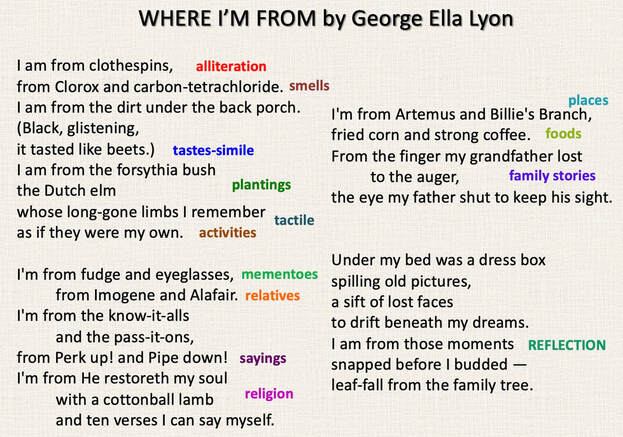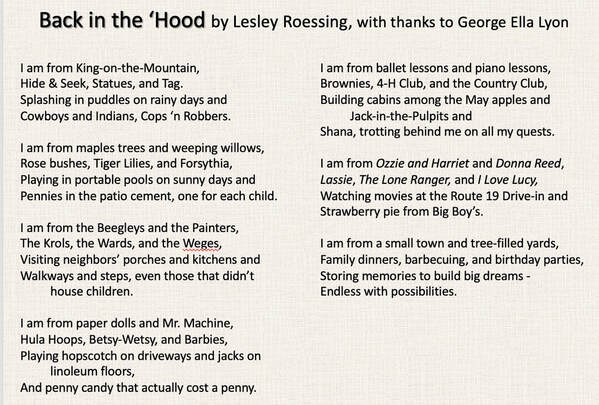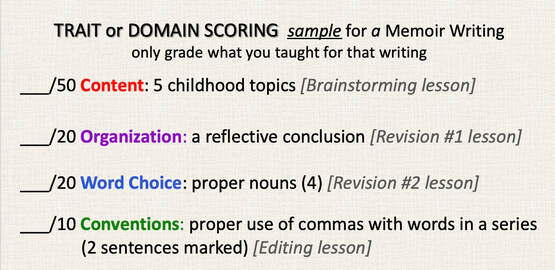- INTRO/SITE CONTENTS
- MY PUBLICATIONS
- BLOG
-
BOOK REVIEWS
- PLANNING A DIVERSE LIBRARY
- Surviving Loss & Abandonment
- Historical Fiction
- Sports Fiction
- Justice & Change Seekers
- Mental Health & Neurodiversity
- Latinx & Hispanic Characters
- Bullying
- Acts of Kindness
- STEM Novels
- Identity & Self-Discovery
- Winter Holidays
- Contending with the Law
- Family Relationships
- Stories of Black History
- Read Across America
- Verse Novels
- Immigrant/Refugee Experience
- Strong Resilient Girls in Literature
- Asian, Asian-American
- Novels featuring Contemporary Jewish Characters
- Multiple Voices & Multiple Perspectives
- Short Readings: Stories, Essays & Memoirs
- Graphic Novels
- Physical Challenges & Illness
- Characters Who are Adopted or in Foster Care
- Love & Friendship
- Memoirs
- STRATEGY SHORTS
|
These are the 10 basic steps and strategies I use for teaching any writing. In this blog, I will take writers through a memoir writing as my example. STEP 1 FREEWRTING As explained in my Writing Strategy #1, FREEWRITING is writing anything that writers think of in response to a prompt. There is no way to freewrite incorrectly. Freewriting can be accomplished in any format—story, memoir, poem, letter, list, essay, stream of consciousness, fiction, nonfiction, humorous, serious, written in 1st, 2nd, or 3rd person,… . A prompt can be a word, a phrase, a quotation, a picture, an object, or music. The prompt should be as general as possible to allow for individual interpretation and writing on the prompt or leading pathways to tangents. One way I have found freewriting to be effective is to have writers freewrite for 4-8 minutes to generate ideas about the topic about which they will be writing to engage the writing brain cells and begin the writing process. Prompts should be as general as possible to allow for or encourage individual interpretation.
Writers may share their freewrites or parts of their freewriting which will lead to more ideas for other writers. STEP 2 READING ALOUD a MENTOR TEXT Writers read through multiple professional examples. In most cases I select and read aloud the first mentor text as an example of the writing students would be drafting (and as an exemplar of the form). One mentor text I employ for memoir writing is George Ella Lyon’s poem “Where I'm From.” STEP 3 DECONSTRUCTING the MENTOR TEXT Students are given a copy of the poem and after the teacher reads aloud the poem, students mark the poem with what they notice about the writing (writer’s craft) and the content. Writers can work in pairs or triads, annotating a copy of the poem. The class members then share what they observed as the teacher marks up a projected copy of the poem which may look like this: This activity gives writers ideas and choices of topics to include and writing crafts or literary elements to incorporate. After the class deconstructs and analyzes the first mentor text, the teacher may add 1-2 other mentor texts so that writers can compare and contrast the examples and determine, name, and list common elements that appear in all examples and note variations that different authors include, depending on teir writing style or their intended audiences. STEP 4 BRAINSTORMING I give writers a topic sheet to fill in to gather and activate their memories. S they filled in their sheets, I fill in mine on the white board, thinking aloud as I enter memories. Writers can ignore me or look up and acquire some ideas from my brainstorming. I tell students that
We take a break for writers to share some of their jottings with a partner or small group and then add some more as they glean ideas from others’ memories. STEP 5 RECONSTRUCTING a Text – Teacher Model After the class together deconstructs a mentor text and in pairs or small group, a few other examples, the teacher shows student-writers how writers take those elements and techniques from the mentor text and put them together, making it ours (synthesis). I ask writers to notice and share what I “borrowed” from Ms Lyon as my memoir-writing mentor and also how my writing differs from hers. Even though I employed some topics and ideas from the mentor text, I wrote in my own style. STEP 6 Showing STUDENT SAMPLES for differentiation If this is not my first year teaching this unit, I share some student samples from previous classes (with permission and without names). If teachers do not have student samples, Bridging the Gap includes examples from Grades 5 to 9 as well as Teacher Models. Students will note that some writers follow the mentor texts very closely while others are more creative. There is no “right” way even though teachers will want certain elements to be included as memoir writing, i.e., a reflective ending. However, we don’t want mentor texts to ever stifle creativity and individual voice. Showing a variety of examples also allows for differentiation. In these examples from Bridging the Gap (and my classroom), we see that Janel followed the mentor text very closely while Doug went in a completely different direction. STEP 7 DRAFTING Students now are ready to write a rough draft, consulting their brainstorming for ideas and referring to the mentor texts for content and form and organization. The most important aspects for successful writing are CHOICE and TIME. With the multiple mentor texts and examples, students have been given some CHOICE in what and how they write. It is vital to give TIME in class to write where they have the teacher and their peers for support and assistance. Also classrooms may house additional mentor texts and other supports for writing. STEP 8 REVISION and EDITING Focus Lessons Revision is the where teachers can teach good writing I teach one lesson (one element) for each writing domain or trait for each writing as students
These lessons are taught as writing Workshop Focus Lessons:
See my blog on Gradual Release of Responsibility Lessons and various Strategy Shorts for Reading and Writing. I then use those lessons as my basis for assessment of that writing. Teachers can also use this as a formative assessment of what to teach or re-teach next. STEP 9 PEER RESPONSE GROUPS and/or or teacher-student conferring In groups of 3, authors read and peers respond to each other’s writings in a prescribed manner to help with revision. The Steps: 1. The Author introduces their writing. *The Author may have something particular they want help with. 2. The Author reads writing—entire piece or portion—to Responders who make notes on their copies (or on a piece of paper, if Author did not bring copies). 3. Each Responder shares:
STEP 10 Final revision and editing for PUBLICATION This is where writers might change their format of their drafts. ------------ TO RECAP: NOTE: Memoir Writing was shown only as an example. These 10 Steps & Strategies can be used, sometimes with some adaptations and modifications, for any writing, such as demonstrated as Writing Strategies #5 and #6 for Informative Writing which incorporates research.
2 Comments
7/14/2023 11:05:07 am
I love this and will be using it as my first unit in Creative Writing!
Reply
Leave a Reply. |
AuthorSee "About Lesley" Page Archives
June 2024
Categories
|
Proudly powered by Weebly















 RSS Feed
RSS Feed